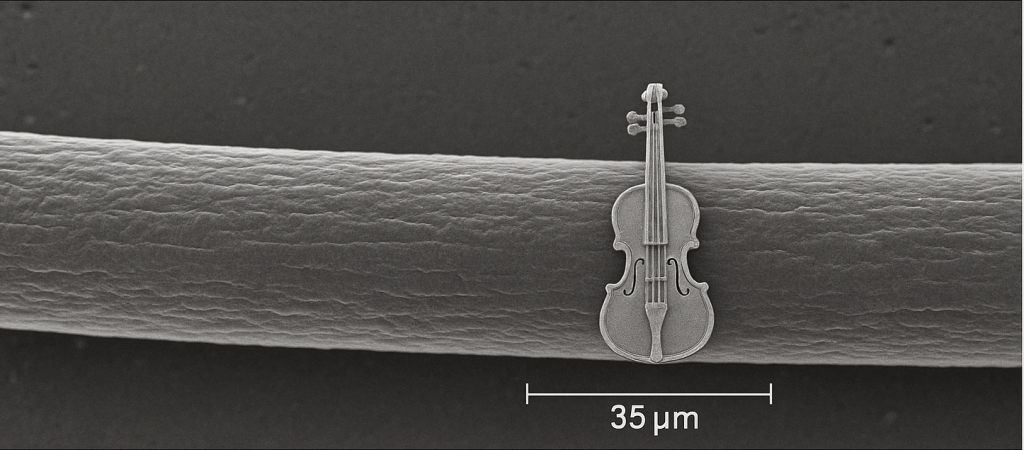World’s Smallest Violin: A Nanoscopic Marvel That Bridges Art, Engineering, and Future Technologies
Introduction
In a brilliant convergence of science and cultural wit, researchers at Loughborough University have constructed what is now known as the world’s smallest violin—so minuscule that it comfortably fits within the width of a human hair. At just 35 micrometers long, this nanoscale violin is not a musical instrument, but rather a masterstroke of nanofabrication—delicate, precise, and symbolic. While it playfully references the meme-like expression “the world’s smallest violin playing just for you,” the implications of this breakthrough are no joke.
This article provides a deep dive into the creation, purpose, and broader technological relevance of this microscopic icon, weaving together insights from multiple science and design platforms including ScienceAlert, IFLScience, DesignBoom, New Atlas, and the official announcement from Loughborough University.
The Violin: Engineering at the Limits of Visibility
Dimensions and Design
The violin measures roughly 35 µm in length and 13 µm in width, dimensions that put it smaller than a single strand of human hair, which typically ranges from 17 to 180 µm in diameter. It’s engraved in platinum on a silicon substrate using a process that pushes the limits of nanoscale engineering.
Despite its whimsical appearance, the violin isn’t meant to play music. It’s a decorative nanosculpture, demonstrating the level of resolution and precision scientists now have in manipulating matter at the nanometer scale. Each violin takes around three hours to etch, highlighting the intricacy involved in crafting even the simplest shapes at such a scale.

The Nanofabrication Process: From Science Fiction to Precision Fact
Creating this nano-violin involved cutting-edge thermal scanning probe lithography, a technique that uses a heated, needle-like tip to etch extremely fine patterns onto a surface. Here’s a step-by-step breakdown of how it works:
- Surface Preparation
A silicon chip is cleaned and coated with two layers of polymer resists—materials sensitive to heat and capable of retaining extremely fine imprints. - NanoFrazor Engraving
Using a Heidelberg NanoFrazor, researchers apply the violin design onto the surface with sub-10 nm accuracy. The NanoFrazor is one of the few commercial tools capable of producing such intricate nanoscale features. - Material Deposition
Platinum is deposited into the etched cavity, after which a cleaning process removes any residual resist. The result is a violin-shaped platinum structure embedded into the substrate.
This process is a proof-of-concept for high-resolution nanolithography, and the playful subject matter was intentionally chosen to showcase the capabilities of this technique in a way that’s engaging to both scientists and the public.
Science Meets Symbolism: Why a Violin?
The choice of a violin wasn’t arbitrary—it is a clever nod to the popular sarcastic expression “Let me play you the world’s smallest violin,” often used to mock exaggerated complaints. The researchers saw this cultural motif as a humorous yet effective way to capture attention and humanize a complex technological feat.
Lead researcher Kelly Morrison commented, “Though creating the world’s smallest violin may seem like fun and games, a lot of what we’ve learned from making it laid the groundwork for the research we’re now undertaking on energy-efficient computing.”
This underscores a larger theme in modern research—science communication through cultural relevance, where whimsical or artistic creations serve as gateways to deeper scientific engagement.
Beyond the Gimmick: Real-World Implications
Though the nano-violin may seem like a novelty, the techniques and technologies used to create it have serious applications, particularly in:
- Data storage: Nanostructures like this violin help test how magnetic materials behave at ultra-small scales, with direct implications for next-gen memory devices.
- Energy-efficient computing: Researchers are using similar patterns to develop thermal logic gates, which process information using heat instead of electricity.
- Material research: The violin-shaped imprint is being used as a testbed to examine how nanomaterials react to stimuli such as electric fields, heat, or magnetic forces.
- Biotechnology and sensing: The same technology could be used to craft ultra-sensitive biosensors or microfluidic devices for diagnostics.
According to DesignBoom, the process and concept are now being considered as educational tools, helping younger audiences appreciate nanotechnology through something playful and relatable.
The Broader Message: Engineering as a Form of Expression
The nano-violin also touches on a deeper, often overlooked perspective in STEM: the intersection of science and art. The violin isn’t merely an experiment or tool—it’s an act of expression. Just as artists use brushes and pigments, scientists used nanolithography to “draw” something whimsical on a scale invisible to the naked eye. It demonstrates how technical mastery can coexist with aesthetic creativity, fostering a richer vision of what engineering can be.
Conclusion: A Symphony of Innovation
The world’s smallest violin may never play a tune, but it speaks volumes about the ingenuity of modern nanotechnology, the importance of science communication, and the evolving role of playfulness in research. In an age where attention is scarce, creating something that resonates both technically and culturally is no small feat.
What began as a humorous experiment is now a compelling proof-of-concept for precise nanoscale patterning, potentially influencing fields ranging from data storage to quantum computing and biotech diagnostics.
And perhaps most importantly—it’s a tiny reminder that even at the smallest scale, science can make a big impact.

